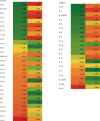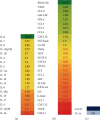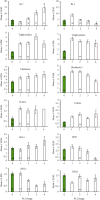Serum Cytokine Alterations Associated with Age of Patients with Nephropathia Epidemica
- PMID: 35059462
- PMCID: PMC8766188
- DOI: 10.1155/2022/4685288
Serum Cytokine Alterations Associated with Age of Patients with Nephropathia Epidemica
Abstract
Nephropathia epidemica (NE) is a zoonotic disease caused by hantaviruses transmitted from rodents, endemic in the Republic of Tatarstan, Russia. The disease presents clinically with mild, moderate, and severe forms, and time-dependent febrile, oliguric, and polyuric stages of the disease are also recognized. The patient's cytokine responses have been suggested to play a central role in disease pathogenesis; however, little is known about the different patterns of cytokine expression in NE in cohorts of different ages and sexes. Serum samples and clinical records were collected from 139 patients and 57 controls (healthy donors) and were used to analyze 48 analytes with the Bio-Plex multiplex magnetic bead-based antibody detection kits. Principal component analysis of 137 patient and 55 controls (for which there was full data) identified two components that individually accounted for >15% of the total variance in results and together for 38% of the total variance. PC1 represented a proinflammatory TH17/TH2 cell antiviral cytokine profile and PC2 a more antiviral cytokine profile with patients tending to display one or the other of these. Severity of disease and stage of illness did not show any correlation with PC1 profiles; however, significant differences were seen in patients with high PC1 profiles vs. lower for a number of individual clinical parameters: High PC1 patients showed a reduced number of febrile days, but higher maximum urine output, higher creatinine levels, and lower platelet levels. Overall, the results of this study point towards a stronger proinflammatory profile occurring in younger NE patients, this being associated with markers of acute kidney injury and low levels of high-density cholesterol. This is consistent with previous work indicating that the pathology of NE is immune driven, with an inflammatory immune response being associated with disease and that this immune response is more extreme in younger patients.
Copyright © 2022 Venera Shakirova et al.
Conflict of interest statement
The authors declare that they have no conflicts of interest.
Figures





Similar articles
-
Differential Cytokine Responses and the Clinical Severity of Adult and Pediatric Nephropathia Epidemica.Int J Mol Sci. 2023 Apr 10;24(8):7016. doi: 10.3390/ijms24087016. Int J Mol Sci. 2023. PMID: 37108178 Free PMC article.
-
Cytokine, Chemokine, and Metalloprotease Activation in the Serum of Patients with Nephropathia Epidemica from the Republic of Tatarstan and the Republic of Mordovia, Russia.Pathogens. 2021 Apr 27;10(5):527. doi: 10.3390/pathogens10050527. Pathogens. 2021. PMID: 33925451 Free PMC article.
-
High Triglycerides Are Associated with Low Thrombocyte Counts and High VEGF in Nephropathia Epidemica.J Immunol Res. 2016;2016:8528270. doi: 10.1155/2016/8528270. Epub 2016 Dec 5. J Immunol Res. 2016. PMID: 28053993 Free PMC article.
-
The pathogenesis of nephropathia epidemica: new knowledge and unanswered questions.Antiviral Res. 2013 Dec;100(3):589-604. doi: 10.1016/j.antiviral.2013.10.001. Epub 2013 Oct 12. Antiviral Res. 2013. PMID: 24126075 Review.
-
The minor problem of hemostatic impairment in nephropathia epidemica, the mild Scandinavian form of hemorrhagic fever with renal syndrome.Rev Infect Dis. 1989 May-Jun;11 Suppl 4:S860-3. doi: 10.1093/clinids/11.supplement_4.s860. Rev Infect Dis. 1989. PMID: 2568675 Review.
Cited by
-
Innate lymphoid cells are activated in HFRS, and their function can be modulated by hantavirus-induced type I interferons.PLoS Pathog. 2024 Jul 22;20(7):e1012390. doi: 10.1371/journal.ppat.1012390. eCollection 2024 Jul. PLoS Pathog. 2024. PMID: 39038044 Free PMC article.
-
Replication kinetics of pathogenic Eurasian orthohantaviruses in human mesangial cells.Virol J. 2024 Oct 1;21(1):241. doi: 10.1186/s12985-024-02517-5. Virol J. 2024. PMID: 39354507 Free PMC article.
-
Rosuvastatin as a Supplemental Treatment for the Clinical Symptoms of Nephropathia Epidemica: A Pilot Clinical Study.Viruses. 2024 Feb 17;16(2):306. doi: 10.3390/v16020306. Viruses. 2024. PMID: 38400081 Free PMC article.
-
Serum Markers Associated with Disease Severity in a Bosnian Hemorrhagic Fever with Renal Syndrome Cohort.Viruses. 2022 Jun 24;14(7):1377. doi: 10.3390/v14071377. Viruses. 2022. PMID: 35891358 Free PMC article.
-
Glomerular Injury Is Associated with Severe Courses of Orthohantavirus Infection.Pathogens. 2024 Aug 16;13(8):693. doi: 10.3390/pathogens13080693. Pathogens. 2024. PMID: 39204293 Free PMC article.
References
Publication types
MeSH terms
Substances
LinkOut - more resources
Full Text Sources
Research Materials
Miscellaneous

